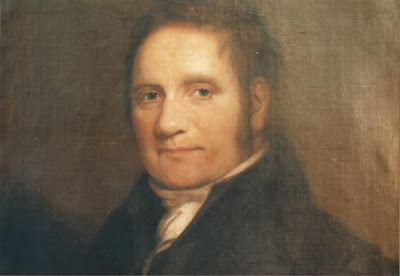The chapel was so small that only a few persons could also be present, apart from those celebrating the Sacred Liturgy. (2) It would seem that the Rites were performed very simply, within the celebration of Low Mass. Almost immediately after the Mass, the new bishop wrote to the President-General of the Benedictine Congregation in England, Father John Augustine Birdsall. (3)
35 Golden Square
 |
| Right Reverend James Yorke Bramston Vicar Apostolic London 1827-1836. |
 |
| Father John Augustine Birdsall OSB President-General of the English Benedictines 1826-1837.Image : http://btsarnia.org |
+John Bede Polding.
I reside at Pagliano's Leicester Square. I shall remain in London till Thursday or Friday.
To be continued ...
 |
| Golden Square in the Soho district of London : an engraving of the 18th century. Image : http://www.british-history.ac.uk |
NOTES
(1) After the tyrant Henry Tudor separated the Church in the Kingdom of England from its allegiance to the Holy See, and following the accession of his Protestant daughter Elizabeth to the throne in 1559, one by one, the Catholic bishops of England were deposed and died, until eventually Apostolic Succession lapsed. In 1623, Pope Urban VIII, with solicitude for the persecuted Catholics of England, appointed a Vicar Apostolic for England, but this was a short-lived remedy. In 1688, the Holy See divided England into four Vicariates Apostolic, with a bishop to lead each. At this time, the public practice of the Catholic Faith was strictly forbidden and frequently subject to persecution. Catholics were deemed traitors to the Kingdom of England. Between 1688 and 1850, there were eleven Vicars Apostolic of the London District. James Yorke Bramston became Vicar Apostolic of the London District in 1827 and died in 1836. This was the bishop who conferred Episcopal Orders on John Bede Polding OSB.
(2) The site of Bishop Bramston's house was on the north side of Golden Square, in the Soho district of London. A large house was completed in 1689 at no. 35 Golden Square and was rebuilt between 1732 and 1737. From 1830 to 1855, no. 35 was the residence of the Catholic Vicars-Apostolic of the London district, commencing with Bishop James Bramston who lived in the the house from 1830 until his death in 1836. Cardinal Wiseman was the last Catholic bishop to occupy the house and in 1856, the silk and wool merchants Messrs. Gagnière moved into the premises and later took over the adjoining nos. 34 and 36. This firm demolished no. 35 in 1914 to allow the erection of a building more suited to commerce, which stills stands on the spot. And so the room where John Bede Polding was consecrated no longer exists. The house at no. 35 was completely distinct from the well-known Chapel of the Assumption, which was built elsewhere in the same square in 1788.
(3) Father John Augustine Birdsall OSB (1775-1837) an Englishman, entered the English-Benedictine House at Lamspringe, in Hanover and was ordained in 1801. After persecutions of Catholic religious in Prussia, he returned to England where he worked zealously as a missionary, though he rarely lived in a Benedictine community. In 1826, he was elected as the President-General of all the Benedictines of England.
(4) Bishop Thomas Griffiths succeeded Dr. Brampston as Vicar Apostolic of the London District in 1836. At the time of Bishop Polding's Consecration in 1834, he was coadjutor bishop of the London District.
(5) Monsignor Etienne Rouchaeux or Rouchouze of the Congregation of the Sacred Hearts of Jesus and Mary was born in France in 1798 and appointed as a Vicar Apostolic of Eastern Oceania in 1833. He was lost at sea in 1843.
(6) One of the many curiosities of the 18th and early 19th centuries was the manner in which Catholic clergyman were referred to throughout the British Empire. A Catholic priest was usually referred to as "Mister". It is even more surprising that Catholic priests referred to each other in this manner. In this letter, Bishop Polding is referring to two Benedictine confreres Dom Luke Bernard Barber OSB and Dom William Dunstan Scott OSB.
AMDG
No comments:
Post a Comment
Note: Only a member of this blog may post a comment.